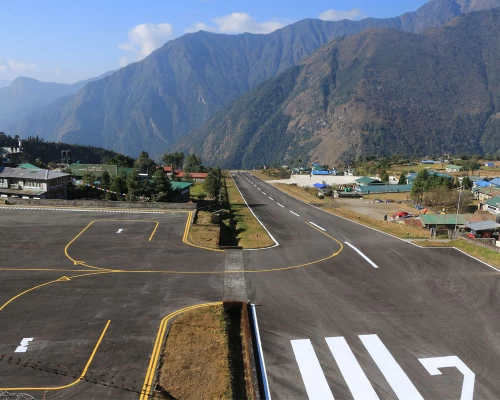Highlights
- Enjoy the stunning view of the mighty Mount Everest from the base camp.
- Learn about the culture and lifestyle of the Sherpas, known as "Protectors of the Himalayas".
- Explore Namche Bazaar, the lively center of the Everest region.
- Discover the amazing plants and animals in Sagarmatha National Park, a UNESCO World Heritage Site.
- Visit Tengboche Monastery, the oldest and most famous spiritual place in the Everest area.
- See other famous mountains like Ama Dablam, Lhotse, Nuptse, Thamserku, and Cho Oyu.
- Hike to famous viewpoints like Kala Patthar (5,644 m) and Nangkartshang Peak (5,121 m) for incredible scenery.
15 Days Everest Base Camp Trek overview
Everest Base Camp Trek is one of the most exciting and beautiful trekking adventures in Nepal, taking you to the base of Mount Everest. The trail passes through Sherpa villages, the famous Sagarmatha National Park, and glaciers, leading to Everest Base Camp at 5,364 meters. This trek also includes the popular Kala Patthar route, which offers amazing views and is a favorite among trekkers worldwide.
Our 15 days Everest Base Camp trek begins with a short and scenic flight to Lukla (2,845 m). From there, you’ll walk through peaceful villages decorated with colorful flags, prayer wheels, and stupas, following the Dudh Koshi River. Along the way, you will reach Namche Bazaar, a lively town perfect for resting and adjusting to the altitude. You will also hike to the Hotel Everest View, where you’ll see Mount Everest, Lhotse, Ama Dablam, and other beautiful peaks, before visiting the Sherpa village of Khumjung.
Other highlights include visiting Tengboche Monastery, the largest monastery in the region, and hiking to Nagarjuna Peak for stunning views of Mount Makalu and the Imja Valley. The trek continues to Lobuche and Gorak Shep, where you will hike to Kala Patthar for incredible views of Everest and a stunning sunset. Finally, you will reach Everest Base Camp, walking alongside the Khumbu Glacier, before heading back to Lukla to complete your trek.
This trek is perfect for anyone who loves nature, mountains, and adventure. It offers beautiful landscapes, rich Sherpa culture, and the excitement of standing at the base of the world’s highest peak. The best times to do this trek are from March to May and September to November, when the weather and trails are at their best.
At Himalayan Joy Adventure, we create an itinerary that fits your needs, giving you enough time to adjust to the altitude and making sure you have the most memorable 15 days of trek to the Everest base camp.
Additional Benefits of EBC Trek with Himalayan Joy Adventure
- Comfortable and Hassle-Free Travel: Enjoy easy airport transfers with private vehicle pickups and drops, plus a 3-night stay in a 3-star hotel in Kathmandu with breakfast, making your time before and after the trek relaxing and comfortable.
- Expert Guidance and Support: Trek with a friendly, experienced English-speaking guide, and have the help of a porter (one porter for every two guests) to carry your bags, so you can focus on enjoying the trek.
- All-Inclusive Trekking Package: Your trek includes three meals a day (Breakfast, Lunch, and Dinner) with tea/coffee along the trail, fresh fruit every evening, and cozy twin-sharing accommodations, providing a complete and worry-free trekking experience.
- Extra Perks for a Memorable Journey: Get a Himalayan Joy Adventure T-shirt and Duffel bag to make your trek even more special, plus a Trip Completion Certificate to remember your adventure.
- Complete Safety and Support: Travel safely with insurance for trekking staff (guides and porters) and included permits (Municipality Entry and National Park), making sure everything goes smoothly and safely during your journey.
Is Everest Base Camp Trek Suitable for you?
Whether the Everest Base Camp (EBC) trek is suitable for you is a subjective question. There is no definitive answer to whether the trek is right for you, as it depends on a few factors such as your fitness level, trekking experience, health condition, and willingness to prepare for the adventure.
Even very fit people can sometimes struggle to complete the trek if they are not well-prepared. That’s why it is very important to have a good plan and an experienced guide. So, they can help you handle the challenges and stay safe along the way.
At our company, we prioritize your safety and success by providing experienced guides and carefully planned itineraries. This approach ensures proper acclimatization and offers the best chance of completing the trek safely and enjoyably.
15 Days Everest Base Camp Trek cost in 2025
The 15 days Everest Base Camp trek costs range from USD $1650 to USD $1900, depending on the group size and the services included. This price typically covers permits, accommodation, meals, and a guide, making it an excellent value for this once-in-a-lifetime adventure.
At Himalayan Joy Adventure, we offer competitive pricing for the 15 days Everest Base Camp trek based on the group size. Larger groups enjoy better rates, and we ensure the same quality of service for all group sizes. Please see the detailed cost breakdown below:
| No of Pax | Starting price (Per Person) |
|---|---|
| 1-2 pax | USD $1900 |
| 3-5 pax | USD $1800 |
| 6-10 pax | USD $1750 |
| 11-15 pax | USD $1700 |
| 16-20 pax | USD $1650 |
To learn more about the cost of the 15 days Everest Base Camp trek or to customize your departure dates and itinerary according to your preferences, feel free to reach out to us on WhatsApp.

































